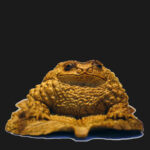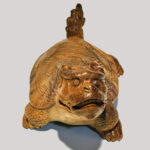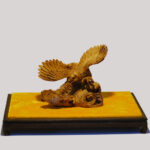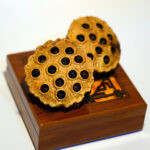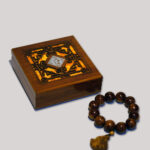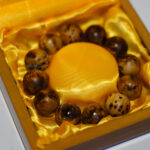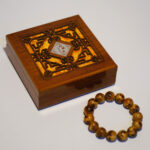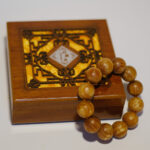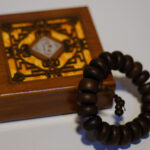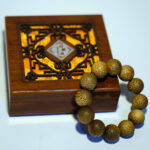Taihang Arborvitae
Taihang Arborvitae: A Marvel of Nature's Transformations

“Taihang Arborvitae” (hereinafter referred to simply as “Taihang Cedar”) is a testament to the vicissitudes of nature. With gnarled and peculiar shapes, intricate and ever-changing textures, and an ancient, pleasant fragrance, Taihang Arborvitae artwork offers a multifaceted sensory experience. As one visually appreciates it, the abundant oils within its texture continuously emanate a captivating aroma. The history of China’s incense culture can be traced back some 6,000 years to the late Neolithic period. Over 3,000 years ago, inscriptions on oracle bones of the Yin Dynasty already contained the character “紫” (meaning firewood used for burning), depicting the ritual of holding burning wood, thereby providing a visual interpretation of incense used in sacrifices.
In folklore, there is the saying, “Thousand-year-old pine, ten-thousand-year-old cedar.” Taihang Arborvitae stands tall on cliffs for millennia, enduring snow at the peaks. Subjected to geographical changes and the harsh tests of nature, it accumulates the essence of resin. The unique aroma of Taihang Arborvitae incense is highly attractive to many practitioners of meditation and enlightenment. Many believe that the fragrance of Taihang Arborvitae more readily transports one’s thoughts back to ancient monasteries, immersing one in the divine realm of towering cedars and curling smoke.
The acceptance of Taihang Arborvitae incense by society is the result of the continuous influence of implicit traditional Chinese philosophical ideas. Sayings such as “Only after the severe winter does it wither” and “It is not until difficult times that one knows the noble character of a person, nor until a bitter cold winter that one knows the resilience of the pine and cedar” have imported the spirit of China’s millennia-old cedar culture, becoming the benchmarks of value for later generations of noble individuals. Similarly, “The fragrance of plum blossoms comes from the bitter cold,” and the fragrance of Taihang Arborvitae also stems from the hardships endured on cliff faces. The fragrance of “Taihang Cedar” embodies traditional life values and the pursuit of ideals spanning thousands of years.
As an objective object, Taihang Arborvitae is not only an aesthetic subject imbued with historical and cultural significance but also creates a transcendent and serene atmosphere for nurturing the mind and practicing meditation through its incense. The solitary and elevated cultural demeanor of Taihang Arborvitae offers people a spiritual realm beyond sensory experiences.
Fruit-like Fragrance (Cool Fragrance)
Taihang Cedar aged material, mostly sourced from the Taihang Mountains (including mountains with similar altitudes in Beijing’s western regions, Hebei, Shanxi, and Henan), due to the cold and arid climate, has dry and hard wood with clear oil. When smelled, it emits a fragrance that is fresh and carries a hint of fruitiness, neither strong nor medicinal, refreshing and delightful, making one want to inhale more.

Sweet Fragrance (Milky Fragrance)
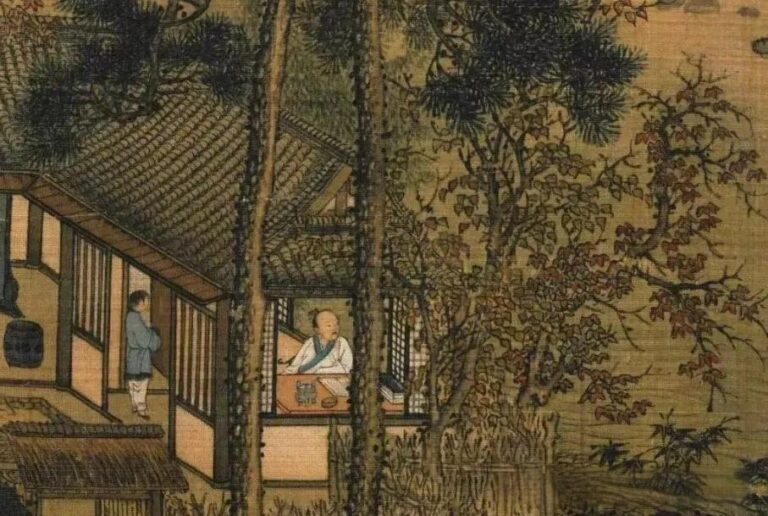
Mostly found in aged Taihang Cedar or Qinling Cedar, this fragrance is similar to the fruit-like fragrance but more intense and sweeter, equally pleasant to smell. However, inhaling too much can become a bit cloying. Qinling aged wood has a darker color, while new wood generally has a lighter color and a noticeable pine resin smell. Genuine aged wood only has a sweet fragrance and is a rare and valuable material. Do not miss out on smelling this Taihang Cedar material.
Medicinal Fragrance
This type of material is mostly sourced from Sichuan (currently, Qinling, Shennongjia, eastern Sichuan, and Chengkou materials are collectively referred to as Sichuan material), with Dabashan material being the best. The aged material from this area generally has a darker color. Some are called dark oil aged material. Due to the humid climate in Dabashan, some Taihang Cedars even produce soil-buried material similar to agarwood, with dark red oil content, capable of sinking in water, and emitting a fragrance that blends medicine, sweetness, and mint.
In the Danfang Xuzhi written by Wu Wu during the Song Dynasty, it is recorded that Qingxia Zi stated: “Half a catty of jiangxiang (a type of incense), five liang of danshen (Salviae Miltiorrhizae Radix et Rhizoma), four liang of suhexiang (Styrax), four liang of laobagen (aged cedar root, referring to Taihang Arborvitae here), four liang of baitanxiang (Santalum album), half a catty of chenxiang (Aquilaria sinensis), and a small amount of baijiaoxiang (a type of resinous incense). Mix these seven ingredients with honey and form them into pills the size of marbles. Burn only one pill each day.”
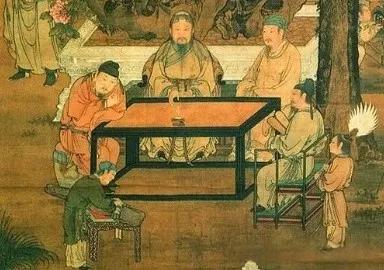
Fruit-like Fragrance (Cool Fragrance)
Calming Effect – It can significantly improve insomnia and dreams. Its fragrance can increase blood oxygen levels, making people feel joyful. In Japan, the fragrance of cedar is known as “air vitamin.” Using Taihang Arborvitae for fumigation to let the aroma surround the patient can improve their mood and enhance their immunity.
Beauty-Enhancing – According to Compendium of Materia Medica, it can “promote the flow of water passages and invigorate the male reproductive system.” Taihang Arborvitae corresponds to the metal element in the Five Phases, which can benefit the lungs and skin. Infusions made from slices of Taihang Arborvitae can moisten the intestines, remove excess oil, promote metabolism, eliminate waste from the body, and nourish the skin.
Anti-Inflammatory – The fragrant aroma of Taihang Arborvitae can purify the air, kill bacteria and viruses, and has anti-inflammatory and swelling-reducing effects. Taihang Arborvitae essential oil is highly effective for treating insect bites and unknown swellings. According to the Chinese Pharmacopoeia, “People with hemorrhoids in eastern Sichuan found sitting on cedar wood had a miraculous effect on pain relief and swelling reduction; boiling its wood in water can nourish hair and treat scabies.”
Taihang Arborvitae belongs to the genus Thuja of the Cupressaceae family. It is distributed on the cliffs of China’s Taihang Mountains, growing in areas above 1,500 meters above sea level. Currently, it has not been artificially introduced for cultivation and is considered an endangered species.
Taihang Arborvitae is a tree or shrub, often forming a pyramid-like shape with thin, scaly bark on the outside and fibrous bark on the inside. It has horizontal or ascending branches, forming unique flat, wave-like branchlets. Each branchlet has four rows of tiny, scaly leaves. Juvenile leaves are longer and needle-like, which can coexist with mature leaves in some species. Monoecious, with cones borne on the ends of branches, male cones are round, pale red or yellow; female cones are small, green or purple-tinged. Mature cones are solitary, oval or oblong, 8 to 16 millimeters long, with 4 to 6 pairs (or 3 pairs, up to 10 pairs) of thin, flexible scales, ending in a thick ridge or protrusion.
